

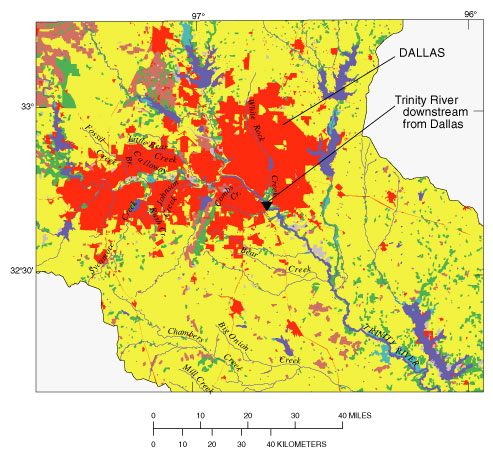
In 1925, the Trinity River in the Dallas-Fort Worth area was characterized by the Texas Department of Health as a "mythological river of death." With a rapid expansion of industry and population and only primary wastewater treatment beginning in the late 1920s and secondary treatment in the mid-1930s, water-quality conditions in the area were poor. They did not substantially improve until State and Federal pollution control laws, like the Federal Clean Water Act of 1972, stimulated efforts to address degraded water-quality conditions. The Upper Trinity River Basin Comprehensive Sewage Plan of 1971 resulted in the construction of large, regional wastewater-treatment plants, elimination of many small, industrial and municipal wastewater-treatment plants, and the upgrading of existing wastewater-treatment plants.
During 1970-85, 13 fishkills were documented in the Trinity River from a reach just downstream from Dallas to Lake Livingston in the lower part of the Trinity River Basin. The magnitude and frequency of the fishkills resulted in a depleted fish community, particularly in the reach of the Trinity River immediately downstream from Dallas. An estimated 1.04 million fish died in these 13 kills. Twelve of the 13 fishkills were associated with minor flooding on the Trinity River from rainfall in the Dallas-Fort Worth metropolitan area. According to the Texas Parks and Wildlife Department (TPWD), the probable cause of the kills was the resuspension of bottom sediments and associated organic material during floods that caused an increase in biochemical oxygen demand and a corresponding rapid drop in dissolved oxygen (Davis, 1987). Ironically, improvements in water quality during the 1970s set the stage for the fishkills by allowing appreciable fish populations to live in this reach of the Trinity River.
During 1970-85, more than 1 million fish were killed by water pollution in the Trinity River downstream from Dallas.
Dissolved oxygen, measured as milligrams of oxygen per liter of water, has increased from lows of near zero in the early 1970s to highs of more than 10 milligrams per liter in 1996. Notable improvement in dissolved oxygen concentrations in the Trinity River downstream from Dallas began in the late 1970s and continued through the 1980s and into the 1990s. Dissolved oxygen was consistently recorded above the TNRCC (Texas Natural Resource Conservation Commission, 1996) dissolved oxygen criterion for the support of aquatic life (5.0 milligrams per liter) beginning in the late 1980s. The improvement in dissolved oxygen concentrations is attributable to improvements in wastewater-treatment practices and the corresponding reduction in the discharge of oxygen-demanding materials from wastewater-treatment plants and industry.

A timeline of change for the Trinity River downstream from Dallas.
Advanced wastewater-treatment processes that include nitrification (conversion of ammonia nitrogen to nitrate) have been implemented at the large wastewater-treatment plants that discharge into the Trinity River in the Dallas-Fort Worth area. Ammonia consumes oxygen when it is converted to nitrate, and large concentrations of ammonia are toxic to fish and other aquatic organisms. Ammonia levels in the Trinity River downstream from Dallas exceeded the TNRCC criterion for dissolved ammonia in freshwater streams and reservoirs (1.0 milligram per liter) consistently until the late 1980s. Since then, the nitrification process used in wastewater-treatment plants has reduced the amount of ammonia nitrogen that is discharged to the river.
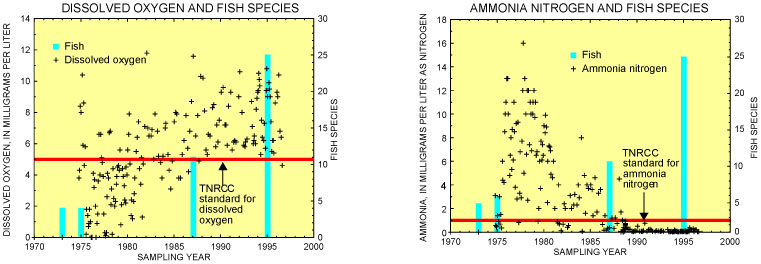
Fish species have increased as water quality
improved in the Trinity River downstream from Dallas.
The fish community in the Trinity River immediately downstream from Dallas was almost nonexistent in the early 1970s (Texas Parks and Wildlife Department, 1974). Only four species of fish were collected by the TPWD during 1972-74—smallmouth buffalo, gizzard shad, common carp, and yellow bass. Four of the six surveys yielded no fish from this reach of the river. Two of the species, gizzard shad and common carp, generally are classified as tolerant taxa and could be expected to tolerate the water-quality conditions in this reach in the 1970s.
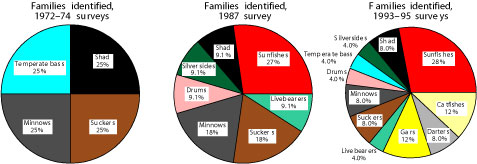
In slightly more than two decades, the fish
community in a reach of the Trinity River downstream from Dallas has markedly
improved. Improvement is most evident in the number of fish caught and the
number of species, including those that are not tolerant of polluted water.
The TPWD collected 11 species of fish from this reach in 1987. Although the 1987 survey yielded more species than the 1972-74 surveys, the TPWD still considered the species richness low and attributed the condition to the fishes' exposure to ammonia nitrogen and heavy trace elements introduced from the upstream wastewater-treatment plants (Davis, 1991).
The USGS conducted fish-community surveys on the
reach at Trinity River downstream from Dallas during 1993-95. The methods used
by the USGS—seining, boat electrofishing, and gill netting—are identical
to the methods used by the TPWD in 1987. A cumulative total of 25 species of
fish were collected in this reach during the 3-year period. Several game species
were collected including largemouth bass, white crappie, and white bass. None
of these game species were collected in the reach during the 1972-74 or 1987
surveys. Two darter species, bigscale logperch and slough darter, also were
collected. The presence of these indigenous species suggests a return of this
reach to a more natural condition. Other species characteristic of warm-water
southeastern streams—alligator, spotted, and longnose gars and flathead,
blue, and channel catfish—frequently were collected during the USGS surveys
of 1993-95. None of these gar or catfish species were reported in the reach
downstream from Dallas in the 1972-74 or 1987 TPWD surveys. The change since
1972-74 is a likely consequence of improvements in water quality, particularly
improvements in the quality of discharges from wastewater-treatment plants in
the Dallas-Fort Worth area.
Fish surveys during 1993-95 indicate that the Trinity River downstream from Dallas is typical of a large stream in the region.
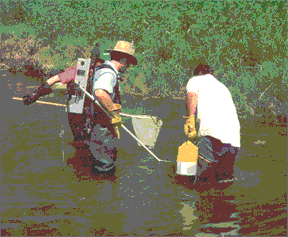
Catching fish with a backpack electrofishing device.
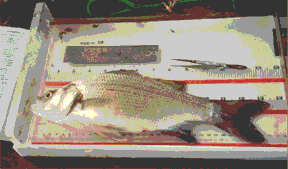
White bass being measured and examined.
| AccessibilityFOIAPrivacyPolicies and Notices | |
 |
|